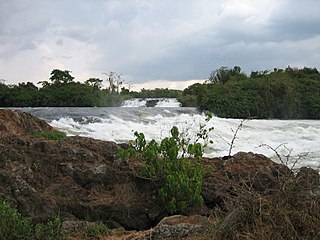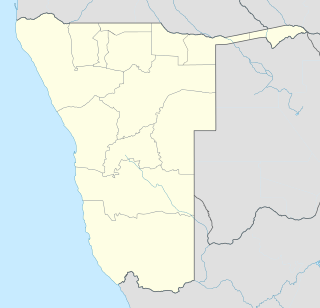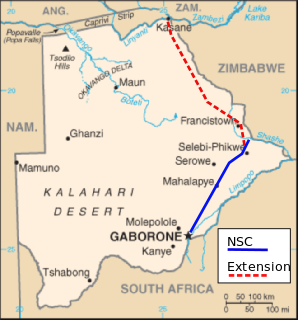
Palapye is a growing town in Botswana, situated about halfway between Francistown and Gaborone. Over the years its position has made it a convenient stopover on one of Southern Africa's principal north–south rail and road routes.

The Morupule Colliery is a coal mine located in Palapye, Botswana, and owned and operated by Debswana, a partnership between the government of Botswana and De Beers. Founded in 1973 to supply the Bamangwato Concessions, Ltd copper and nickel mine, operations have expanded considerably since then to supply regional power plants and industries, especially the nearby Morupule Power Station. A small wash plant, with a production capability of 120 tonnes per hour, was commissioned in January 2008 to supply a higher quality coal to local and regional consumers. This project was supported by the Botswana government as a means of stimulating the local economy, producing a less polluting form of coal than the run-of-mine coal, and to provide an alternative to the unsustainable use of wood for cooking and heating.
Zimbabwe Electricity Supply Authority, (ZESA) whose official name is ZESA Holdings (Private) Limited, is a state-owned company whose task is to generate, transmit, and distribute electricity in Zimbabwe. It has organized this task by delegation to its subsidiaries, the energy generating company Zimbabwe Power Company (ZPC) and the Zimbabwe Electricity Transmission and Distribution Company (ZETDC). Other subsidiaries are the investment branch ZESA Enterprises (ZENT) and internet provider PowerTel Communications (Private) Limited. ZESA is the only electricity generator and supplier for the public grid. For many years the company has failed to produce enough energy to meet demands. ZESA produced an estimated 6.8 billion kWh in 2016, while demand was estimated at 7.118 billion kWh. ZESA represents Zimbabwe in the Southern African Power Pool.
List of Railway stations in Botswana include:

The Bujagali Power Station is a hydroelectric power station across the Victoria Nile that harnesses the energy of its namesake; the Bujagali Falls, in Uganda. Construction began in 2007 and concluded in 2012. It was officially inaugurated on 8 October 2012 by Ugandan President Yoweri Museveni and Aga Khan IV in the presence of African politicians and investors.

The Ruacana Hydroelectric Power Station is a hydroelectric power plant near Ruacana in northwest Namibia, close to the Angolan border. Commissioned in 1978, it is by far the largest power station in Namibia. Its operator is NamPower, the Namibian national electric power utility company.

The Jebba Hydroelectric Power Station, also Jebba Power Station, is a hydroelectric power plant across the Niger River in Nigeria. It has a power generating capacity of 578.4 megawatts, enough to power over 364,000 homes. The plant was commissioned on 13 April 1985, although commercial energy production began in 1983.
Botswana Power Corporation (BPC) is a state owned company for electrical power generation, transmission and distribution in Botswana. It was established in 1970 and is currently the only electricity supplier in the country. BPC produced an estimated 1,052 GWh in 2007, while demand was estimated to 2,648 GWh. BPC represents Botswana in the Southern African Power Pool. Morupule Power Station (coal-fired) in Palapye supplies 80% of domestically generated electricity, however the country is dependent on importing energy from its neighbours. Its capacity is estimated to be around 132 MW. Since the regions main power generator South Africa is experiencing its own problems with undercapacity blackouts are a problem. A plan to boost Morupule station with four new 150 MW units is underway and gathering financial support from several sources.

The North-South Carrier (NSC) is a pipeline in Botswana that carries raw water south for a distance of 360 kilometres (220 mi) to the capital city of Gaborone. Phase 1 was completed in 2000. Phase 2 of the NSC, under construction, will duplicate the pipeline to carry water from the Dikgatlhong Dam, which was completed in 2012. A proposed extension to deliver water from the Zambezi would add another 500 to 520 kilometres to the total pipeline length. The NSC is the largest engineering project ever undertaken in Botswana.
Tanzania has a wide range of energy resources in abundance, which are not yet fully exploited. These include; wood fuel, other biomass fuels, hydropower, natural gas, coal, wind, geothermal, uranium and solar.
The Kipeto Wind Power Station, also Kajiado Wind Power Project, is a 100 megawatts (130,000 hp) wind-powered electricity power station in Kenya. It is the second-largest wind farm in the country, behind the 310 megawatts Lake Turkana Wind Power Station.
Kanzimbe Solar Power Station, also Salima Solar Power Station, is a 60 megawatts (80,000 hp) solar power plant, under construction, in Malawi, in Southern Africa.

Absa Bank Botswana, formerly known as Barclays Bank of Botswana Limited, is a commercial bank in Botswana, licensed by the Bank of Botswana, the country's central bank and national banking regulator.

Bank SBI Botswana Limited, formerly State Bank of India Botswana Limited, is a commercial bank in Botswana. It is licensed by the Bank of Botswana, the central bank and national banking regulator.
Zagtouli Solar Power Station, is an operational 33 MW (44,000 hp) solar power plant in Burkina Faso. At the time of its commissioning, in November 2017, it was one of the largest, grid-connected solar power station in West Africa.
The Oyster Bay Wind Power Station is an operational 140 MW (190,000 hp) wind power plant in South Africa. The power station was developed and is owned by Enel Green Power, a subsidiary of the Italian energy conglomerate, Enel, headquartered in Rome. The energy generated at this wind farm is sold to the South African national electricity utility company Eskom, under a 20-year power purchase agreement (PPA).








